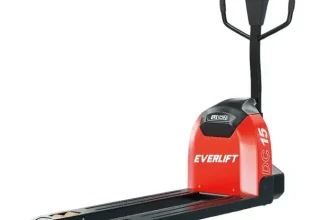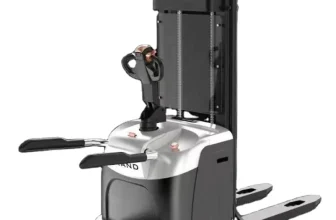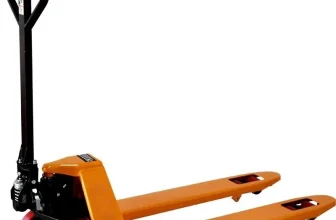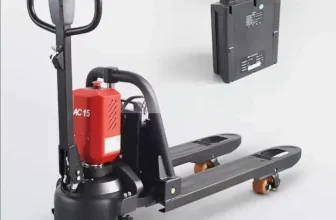Pallets are a clever solution for stacking and moving goods in a warehouse or other storage and distribution area. The genius lies in the ease of lifting, moving, and placing items as pallets come in standard shapes and sizes. Pallet jacks are the other clever addition, effectively solving the moving part of the process.
Pallet jacks have a lightweight design that hides their incredible loading capacity. The physics of the tool is fascinating, enabling you to move huge loads easily.
You need to understand how pallet jacks work to make the most of them. Additionally, the safe handling of pallet jacks minimizes warehouse accidents and keeps them in proper working order. This article shares some insights to help you while using the pallet jack.
What Is a Pallet Jack?
A pallet jack is a simplified forklift with a wheeled trolley, handle, hydraulic pump, linkages, load wheels, and forks. The forks roll under the load, and the hydraulic pump raises them to lift the load off the floor and allow the wheels to roll. You then pull the handle, thus moving the load to wherever you need to.
Pallet jacks differ from forklifts in design simplicity and lack a counterweight. Forklifts have a counterweight to balance with the load being carried, thus allowing for its movement. Pallet jacks have wheels at either end of the forks, so they don’t need the counterweight.
Additionally, forklifts need the operator to sit or stand between the load and the counterweight. In contrast, pallet jacks need the operator to stand in front or behind them and use the handle to pull or push.
Furthermore, forklifts are powered, while pallet jacks can be powered or manually operated. Forklifts also enable you to lift the load high for stacking. The way pallet jacks work doesn’t allow for stacking. Instead, the load is lifted enough for the wheels to roll smoothly. Therefore, pallet jacks are ideal when you only need to move the load.
The genius of pallet jacks is how they enable the easy movement of goods. Initially, workers had to lift heavy boxes and strain walking across the warehouse. Pallet jacks can be loaded and moved without breaking a sweat. This way, more work is done in less time, and fewer accidents happen in your warehouse. Additionally, you’ll have better warehouse organization as your staff is less strained and more focused.
Types of Pallet Jacks
- Manual Pallet Jack
The manual pallet jack is the simplest and most common pallet jack. As the name suggests, the operator works the machine manually. You first slide the forks under the pallet, then pump the handle up and down to lift the load off the ground. Once the load is balanced and off the ground, the operator pulls or pushes the handle to move the load.
Manual pallet jacks are small in size, making them easy to transport. However, they are not ideal for moving goods over long distances. Additionally, they are suitable for indoor use where the floor is flat and even. Rough terrain makes them harder or impossible to operate.
The electric walk-behind pallet jack is the powered version of the manual variety. It is usually twice the size and has an engine or battery pack. This pallet jack works the same way, except the operator doesn’t have to pull or push the jack. They only steer it and stop it once at the destination. This jack enables you to move heavier loads over longer distances.
The biggest advantage of electric walk-behind jacks is the ability to move heavier loads. However, you’ll need to recharge the machine, which makes them useless once they power down. Additionally, the machine needs regular maintenance to keep them functioning optimally. Therefore, you have to contend with the extra costs.
Furthermore, while you only need to steer the pallet jack, it can only move as fast as you. Therefore, you can only work at a slow pace, which is a disadvantage if you have many things to move.
This pallet jack is a more advanced version, where the operator drives the machine instead of walking behind or alongside it. The standing platform gives you access to a simple set of controls and enables you to move loads much faster than the walk-behind pallet jack. This jack allows you to move heavier loads over longer distances due to its more powerful battery packs. However, there is no operator protection when you are closer to the load.
These pallet jacks are ideal for moving loads over rough terrain and longer distances. A counterweight is attached to prevent a heavy load from tipping the setup. However, their sheer size makes them less maneuverable. You’ll find using them in tight spaces, and their turning radius is significantly large.
These are the most robust pallet jacks, with durable wheels, a wider frame, and a beefy battery pack. They are ideal for moving loads at outdoor construction sites, and the battery pack makes such work easier to handle.
How to Use a Pallet Jack
Manual and powered jacks differ in how they move the load, but their operation is the same.
First, hold the jack by the handle while ensuring the forks face the loaded pallet board and are positioned ready to slide under it. Most manual pallet jack designs are simple enough to ensure you locate the release lever easily.
Next, push the pallet jack up to the loaded board and the release lever downwards to lower the forks. You should easily slide the forks into the pallet board’s spaces using the jack’s handle. When the forks slide into the pallet board, ensure they go all the way through and rest on the floor and not on any part of the pallet board.
Next, jack up the pallet using the handle. The hydraulic lift mechanism requires the jacking motion to lift the loaded pallet board until it is a few inches off the ground. You will feel some resistance once the pallet’s weight rests fully on the forks. Keep going until no part of the pallet’s floor touches the floor. This ensures there is no dragging when you move the jack.
You can then move the pallet to wherever you need it, then release the forks by pushing down the lever.
Most powered pallet jacks have battery packs that require they remain connected to charging stations when not in use. Therefore, you first need to unplug them from the chargers.
Next, position the jack so the forks face the loaded pallet. You should see a control section on the jack’s handle. Find the release button to lower the jack’s forks.
Next, press the forward motion button to slide the forks into the pallet’s attachment points. Ensure the forks move all the way through for safe carrying. You then need to press the up button to lift the pallet off the ground. Check that no part of the pallet bottom touches the floor.
You then press the motion buttons in whichever direction you want to take the loaded pallet. The down button should now lower the pallet board safely on the floor.
How to Safely Use a Pallet Jack
Despite being a simple tool to use, pallet jacks can cause significant damage and bodily harm. Therefore, you need to observe safety and common sense when using one.
Before using the jack, check that its components are in safe working condition. Things like loose springs, rickety wheels, faulty levers, and bent forks are dangerous, and the jack needs repairs before use. A simple inspection takes a few minutes but could save you so much pain and loss.
You then need to check the path you will use for any debris or other obstacles. Additionally, select the least bumpy route to your destination. As mentioned, most pallet jacks work well on even surfaces. Only off-road pallet trucks can go over rough terrain, and you’re not likely to find those indoors.
Be especially keen on who operates the powered pallet jacks. Assign pallet handling duties to specific individuals for safe operation and accountability.
You also need to store unused jacks in a safe area accessible only by authorized personnel. Besides theft and vandalism, amateurs may attempt to use them, resulting in damage or injuries.
Conclusion
Pallet jacks are a great addition to your goods storage and distribution business or department. They are cheaper and just as efficient as forklifts while reducing strain and injuries associated with manual lifting. You only need to ensure your staff knows how to operate them and to do so safely. With proper care and maintenance, pallet jacks will serve you for a long time. These are indeed great investments.







